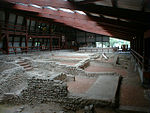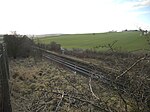Eynsford

Eynsford ( or ) is a village and civil parish in the Sevenoaks District of Kent, England. It is located 3.3 miles (5 km) south east of Swanley, 7 miles (11 km) south of Dartford. The village including its farmland and woods occupies the northern half of the triangle formed by three motorways in west Kent barring its very northernmost part which is Farningham. This area is undulating and has a large minority of woodland. In the south of the parish is Lullingstone, much of which was owned for many centuries by the large, late medieval Lullingstone Castle, whereas other parts of the village were owned by Eynsford Castle, which is older. Well before the founding of the Kingdom of England, Lullingstone Roman villa was founded in this part of the parish, which is open to the public today. The Darent Valley Path takes in a cross-section of the area.
Excerpt from the Wikipedia article Eynsford (License: CC BY-SA 3.0, Authors, Images).Eynsford
Pollyhaugh,
Geographical coordinates (GPS) Address Nearby Places Show on map
Geographical coordinates (GPS)
| Latitude | Longitude |
|---|---|
| N 51.365 ° | E 0.211 ° |
Address
Pollyhaugh
Pollyhaugh
DA4 0HE , Eynsford
England, United Kingdom
Open on Google Maps









